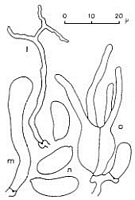|
 Exidiopsis novae-zelandiae Exidiopsis novae-zelandiae
SynonymsSebacina novae-zelandiae
BiostatusPresent in region - Indigenous. Endemic
Images (click to enlarge)
Caption: Sebacina novae-zelandiae: I, branched dikaryophyses; m, paraphysoid; n, spores; o, basidia. |
Article: McNabb, R.F.R. (1969). New Zealand Tremellales - III. New Zealand Journal of Botany 7(3): 241-261 (http://www.rsnz.org/publish/abstracts.php).
Description: Fructifications soft to waxy-gelatinous,
resupinate, thin, effused, indeterminate, forming irregular areas to 10 cm in
longest dimension, greyish-hyaline to bluish-grey when fresh, surface pruinose
to farinaceous, drying to a hyaline to greyish-white film; margins concolorous,
adnate. In section 50-100 µm thick, composed of basal layer and hymenium. Basal
layer thin, indistinct, composed of thin-walled, hyaline, agglutinated hyphae
lying parallel with substratum, clamp connections present. Fertile hyphae hyaline,
thin-walled, tortuous, 2-4.5 µm diam., clamped. Hymenium composed of dikaryophyses,
paraphysoids and basidia; dikaryophyses abundant, arising from basal hyphae
or base of fertile hyphae, projecting 10-30 µm beyond basidia, nodulose, clamped,
finely and irregularly branched apically; paraphysoids sparse to abundant, arising
from base of fertile hyphae, variable in shape but typically irregularly cylindrical
to subclavate, hyaline, thin-walled, devoid of coloured contents, 25-80 x 5-10
µm; probasidia initially cylindrical to clavate, later broadly obovate to pyriform,
proliferating through or near basal clamp connections, 14.3-19.2 x 10-13.4 µm,
becoming longitudinally cruciate-septate; sterigmata cylindrical, to 45 x 3-4
µm. Basidiospores cylindrical, curved-cylindrical, or ovate and flattened on
one side, hyaline, aguttulate, apiculate, 10.4-15.6-(17.3) x 4.8-6.5-(7.2) µm.
Germination by repetition, or by stout germ tubes.
Habitat: Dead angiosperm wood.
Notes: The absence of both thick-walled cystidia
and gloeocystidia with coloured contents indicate that this species belongs
in sect. Sebacina. It closely resembles S. umbrina. Rogers but
spores of S. novae-zelandiae are considerably broader and range in shape
from curved-cylindrical to ovate and flattened on one side.
|